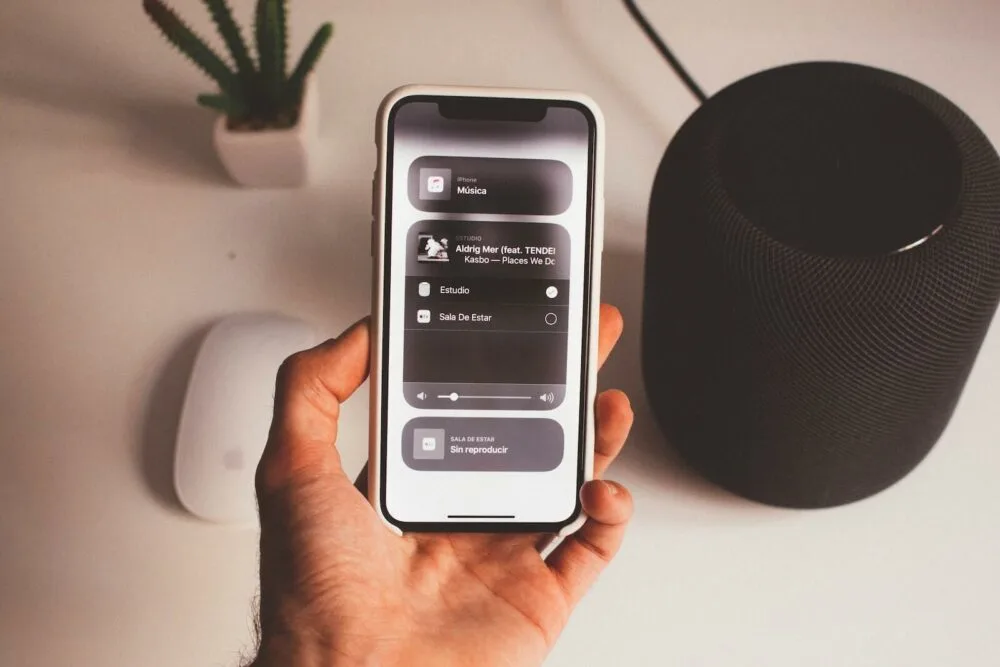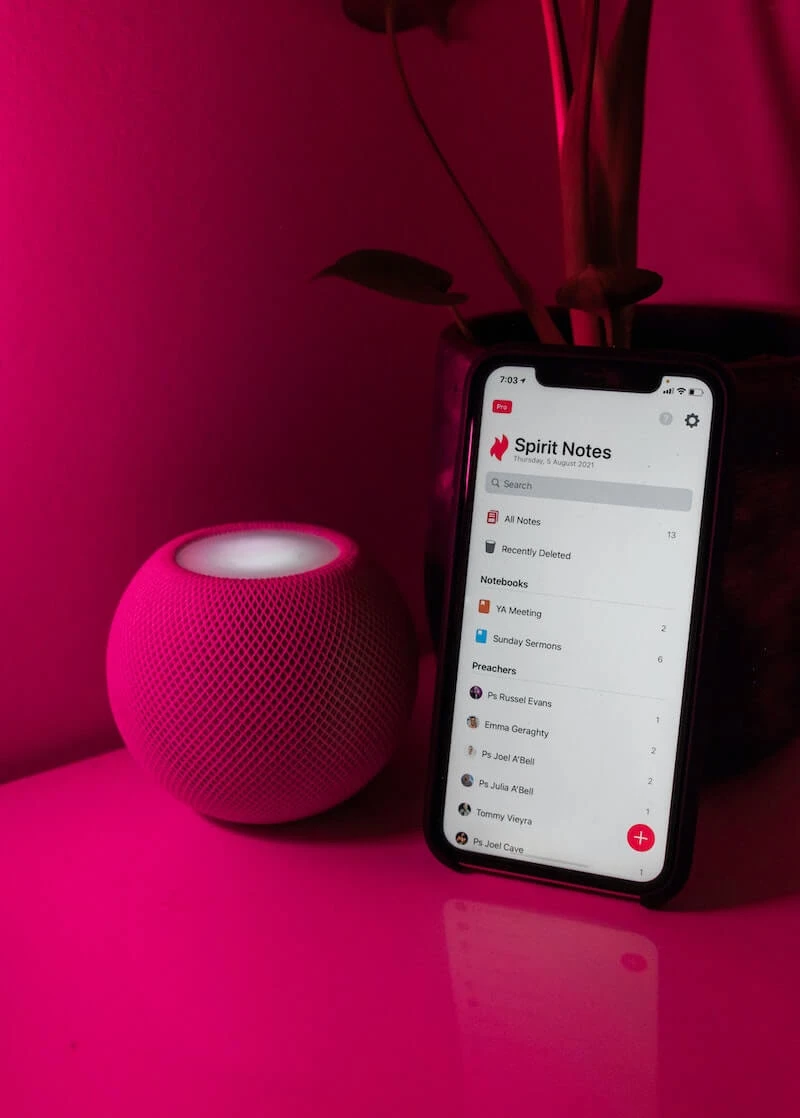Apple launched the HomePod in 2018, and it flopped. Other brands like Google and Amazon had already been a part of the smart speaker landscape, and Apple was a bit late (and expensive) to the party. Therefore, Apple launched a HomePod Mini in 2020 to compete with the other brands. So how does a HomePod compare to a soundbar when watching TV series and movies? Let’s analyze the HomePod vs. Soundbar and discover it.
If you still have one of the former HomePods or you own and Mini and you’re asking yourself whether it’s worth investing in a soundbar or maybe adding a second HomePod, we’ll discuss both options and help you decide.
Oh, and before moving to the analysis, Apple just launched a new version of the HomePod in 2023 with a $50 discounted price. The design and features remain mostly the same as the first version launched in 2018, with a few updates to catch up with the mini and fewer microphones and speakers to get those $50 off the final price.
The original HomePod packs a punch and delivers an excellent sound experience. It’s designed to give you 360-degree sound without any additional speakers or subwoofers connected. The HomePod also has built-in microphones that can be used for voice commands, music playback, and hands-free calls. Additionally, Apple’s AirPlay 2 technology allows you to stream content directly from your iPhone, iPad, or Mac to the speaker without wires.
However, when it comes to watching movies and TV shows, things might be slightly different. Soundbars have existed for a while, and they’re designed to enhance the sound of your TV (those crappy integrated speakers), providing both stereo and surround sound depending on the model you choose.
Soundbard were made for TVs. The HomePod was made as a smart speaker that also plays great music and can be used in a home theatre. Here’s how they compare to each other in different categories:
HomePod vs. Soundbar: Sound Quality
HomePod’s sound quality is great for music, podcasts, and conversations. It’s designed to provide 360-degree sound after analyzing the room and its acoustics. However, even if it comes with multiple tweeters, it still feels like a mono speaker. As for music, it’s great. But when you’re watching TV, it feels like the sound comes only from one side, which can be disappointing.
Of course, you can always buy a second HomePod and pair them in stereo mode, but that would double the cost. Even then, you don’t have a central channel usually dedicated to voices and dialogs. Therefore, it’s not the best option for movies and TV series, but it rocks for music. The bass is also punchy and plentiful overall. The HomePod Mini doesn’t have great sound, although it’s still better than integrated TV speakers.

On the other hand, a soundbar also comes with multiple speakers, but it’s usually dedicated to different types of sounds. Some models come with a center channel like the ones in a 5.1 home cinema, and some models can even simulate surround sound for movies and music. Since the soundbar has a larger area, the speakers feel more separated, creating a more realistic soundstage.
One area where the soundbar probably doesn’t win is in the bass department. It simply can’t compete with the HomePod (not Mini) unless you connect an external subwoofer.
At the end of the day, the sound quality of a soundbar also depends a lot on the price you choose to pay. High-end models will cost you more and deliver better sound quality than cheaper ones.
With the price of 2 HomePods, you can buy a nice soundbar setup or arguably even a whole home theater with surround sound. With the price of 1 HomePod Mini, you can barely get a decent small soundbar.
Soundbar vs. HomePod: Design
In terms of design, the HomePod is undoubtedly the winner here. It’s designed to blend with any living room or office and can even be a smart speaker. It comes in 2 different sizes, and you can choose from white or space gray. Both sizes are pretty manageable in terms of space required. Apple never fails in the design area.
On the other hand, a soundbar is designed to fit in front of your TV and usually takes up a bit more space than the HomePod. However, that space is generally empty and doesn’t take any area from the sides of the TV where you would install other speakers. Besides that, you can mount a soundbar on the wall and forget about it.

The HomePod is 100% wireless and only has 1 AC cable, so hiding the wires is easy and convenient. The same can be said of soundbars, but you usually need a few more connections for the TV if you buy an external subwoofer or your model supports it.
Overall, in terms of design, it’s a tie and comes down to personal preference.
HomePod vs. Soundbar: Connectivity
Connectivity can be a big issue depending on the ecosystem you choose. If you’re an Apple user and already own an Apple TV, then the HomePod is definitely for you. You can stream music from any streaming service that supports AirPlay 2 and is even compatible with Siri. You can also connect multiple devices to control your music using multiroom audio. Your Mac, iPad, and iPhone/iPod are included.
The connection is seamless, and you can tap the HomePod Mini with your iPhone, and it will automatically start playing whatever you are playing on the other device. If you’re not an Apple user, things can get annoying quickly.
You can’t use the HomePod like a traditional Bluetooth speaker, and it doesn’t have an aux input either. The only option to connect non-Apple devices is to buy an Apple TV or Airplay 2 adapter, which can be expensive depending on your chosen model. Many Smart TVs come with AirPlay or AirPlay 2 nowadays, but the experience isn’t as seamless as with other Apple devices.

On the other hand, soundbars are usually more versatile regarding connectivity. Most have Bluetooth, HDMI, Optical, and aux inputs, and some even have Wi-Fi. So if you’re not an Apple user, soundbars can be a better option since you’ll be able to connect to any device and stream music or watch movies.
Most people use the HDMI connector to pass audio and video from their TV to the soundbar and then connect other devices like smartphones or consoles with Bluetooth. This way, you can stream music from any device while having your TV always connected to the soundbar. The optical cable is another excellent option, and having a physical wired connection always makes audio sound better and avoids synchronization or audio lag issues.
Overall, unless you have an Apple TV or you’re well versed in the Apple ecosystem, soundbars can be a better option in terms of connectivity.
HomePod vs. Soundbar: Setup
Setting up the HomePod is easy, and it’s pretty much plug-and-play. All you have to do is connect your HomePod to power, use your iPhone to sync it with your Apple ID, and that’s it. Then you can start streaming music or use Siri to control the HomePod.
Your HomePod will be available for all your Apple devices, including an Apple TV, making the connection seamless and enjoyable. “It just works.” However, if you don’t have an Apple TV, you will need to set up the connection with your Smart TV via AirPlay 2, which requires a couple more steps.
The connections are primarily physical with a soundbar, and you don’t have to set up anything else. Plug the soundbar to power, connect it to your TV with the HDMI or Optical cable, and you’re good to go. If you want to sync your phone with the soundbar, you may need a couple more steps depending on the model since some use Bluetooth, but for TV movies and series, you’re good to go. You might need to check the audio output is set correctly on your Smart TV, but that’s it.

In terms of setting things up, a soundbar is more convenient for non-Apple users or older people. Connect it, and it works. It’s not like setting up a HomePod is complicated or anything like that, but it requires a few extra minutes, and if you have any connectivity issues, it can get frustrating.
Soundbar vs. HomePod: Cost
Finally, let’s talk about the cost. The HomePod Mini starts at $99, a reasonable price for a smart speaker. However, buying a pair or buying the regular HomePod will add up. A regular HomePod retails for $299, and if you want to buy a pair, the price goes up to $599. That’s a lot of money for an audio setup.
Soundbars, on the other hand, start at around $100, and you can find excellent models between $250-400. You can even spend up to $1000 if you want something high-end, but that’s not necessary, and I’d recommend buying a high-quality audio setup (forget about soundbars or smart speakers) with that amount of money.
Unless you have pretty lousy hearing, you probably want at least 2 HomePods for stereo sound for your TV, meaning you’ll have to spend $198 – $598. For $198, you can only buy a decent soundbar, but for $598, you can buy a top-tier soundbar or a surround set up, plus an extra subwoofer and some other goodies. So there’s no question that soundbars are the better option in terms of cost. You won’t have any smart speaker or smart home capabilities with the soundbar, though.

Are There Better Alternatives?
In terms of audio quality, HomePods, and soundbars are both great options if you want to improve the tv or movie-watching experience. However, if you want something high-end and incredible audio quality, you should buy a full-fledged audio setup like speakers and amplifiers.
The downside is that it requires more space and money, and it’s also more challenging to set up since it involves wiring several devices together. But if you don’t have any budget restrictions, this is the way to go if you want the best audio experience.
You can also get a pair of Sonos or Bose speakers, which offer better audio quality than the HomePod, in a similar design package and price. Still, they don’t have Siri or full integration with your Apple devices.
The upside, though, is you can probably set them up as regular Bluetooth speakers. Therefore they’ll be compatible with any computer, Android device, or other electronic at home.
The Bottom Line
If you’re looking for a simple and cheap solution to improve the sound coming out of your TV, then a soundbar is the better option. It’s easy to set up and usually more affordable than buying a pair of HomePods. Plus, you don’t need an Apple device to use it. If you want to spend over $200 and have the space, forget about HomePods and soundbars and get a full-fledged audio setup.
However, if you already have multiple Apple devices and want something that integrates well with your home, then the HomePod might be worth considering. But remember it’s slightly more expensive, especially if you buy a pair. And there you have it. Let us know in the comments if you have questions about soundbars and HomePods for TV and movies. We’ll do our best to help you out!